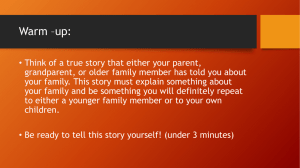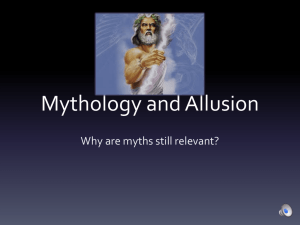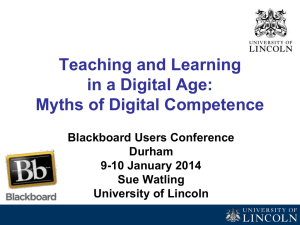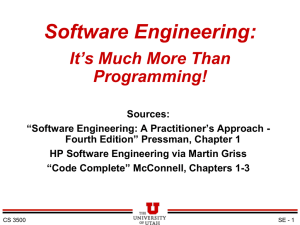Software Engineering 軟體工程
advertisement
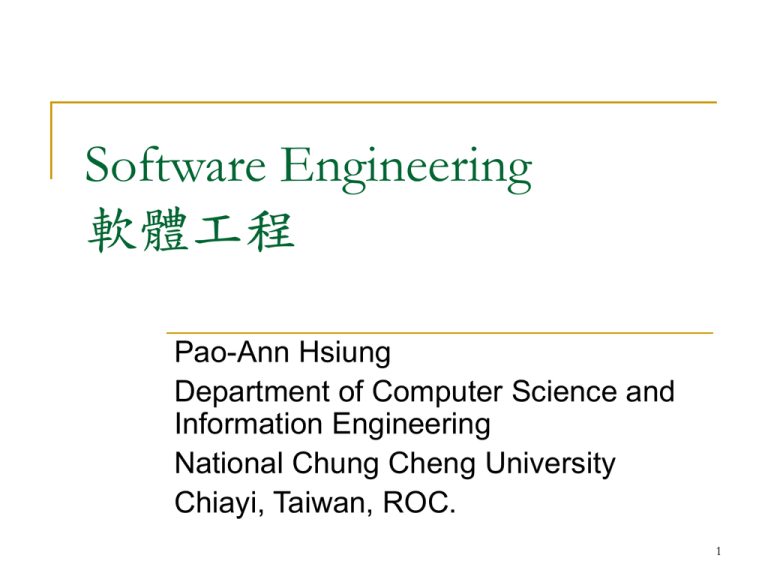
Software Engineering 軟體工程 Pao-Ann Hsiung Department of Computer Science and Information Engineering National Chung Cheng University Chiayi, Taiwan, ROC. 1 Course Objectives To learn about all the difficulties in developing software so that we can avoid pitfalls and myths in software design To learn about different software processes so that we can choose a suitable one To learn to design high-quality efficient software so that it is usable and maintainable To learn about advanced methods for software engineering 2 Course Contents Introduction to Software Engineering Software Processes Requirements Engineering Software Design Object-Oriented Software Development Software Testing and Verification Software Project Management Advanced Methods 3 Chapter 1 Introduction to Software Engineering An overview of software engineering, including software crisis, myths, methods, evolution, and status 4 Contents Software Crisis Software Myths What is Software Engineering Evolution of Software Engineering State-of-art in Software Engineering 5 The statistics – Chaos Report Standish Group – 1995 365 IT executives in US companies in diverse industry segments. 8,380 projects In Averages • 189% of original budget • 221% of original schedule • 61% of original functionality Project completion average time overrun = 222%. 61% of originally specified features included On time, on budget, with all of the specified features and functions 16% 53% ? Cancelled before they were completed 31% average cost overrun = 189% delivered and operational but overbudget, over-schedule or with fewer features and functions than specified 6 Symptom of Software Crisis About US$250 billions spent per year in the US on application development Out of this, about US$140 billions wasted due to the projects getting abandoned or reworked; this in turn because of not following best practices and standards Ref: Standish Group, 1996 7 Symptom of Software Crisis 10% of client/server apps are abandoned or restarted from scratch 20% of apps are significantly altered to avoid disaster 40% of apps are delivered significantly late Source: 3 year study of 70 large c/s apps 30 European firms. Compuware (12/95) 8 Observed Problems Software products: fail to meet user requirements crash frequently expensive difficult to alter, debug, enhance often delivered late use resources non-optimally 9 Why is the Statistics so Bad? Misconception on software development Software myths, e.g., the man-month myth False assumptions Not distinguishing the coding of a computer program from the development of a software product Software programs have exponential growth in complexity and difficulty level with respect to size. The ad hoc approach breaks down when size of software increases. 10 Why is the Statistics so Bad? Software professionals lack engineering training Programmers have skills for programming but without the engineering mindset about a process discipline Internal complexities Essences and accidents made by Fred. Brooks 11 How is Software usually Constructed … The requirements specification was defined like this The developers understood it in that way That is the program after debugging This is how the problem was solved before. This is how the program is described by marketing dept. This is how the problem is solved now This, in fact, is what the 12 customer wanted … ;-) Software Myths (Customer Perspectives) A general statement of objectives is sufficient to get started with the development of software. Missing/vague requirements can easily be incorporated/detailed out as they get concretized. Application requirements can never be stable; software can be and has to be made flexible enough to allow changes to be incorporated as they happen. 13 Software Myths (Developer Perspectives) Once the software is demonstrated, the job is done. Usually, the problems just begin! 14 Software Myths (Developer Perspectives) Until the software is coded and is available for testing, there is no way for assessing its quality. Usually, there are too many tiny bugs inserted at every stage that grow in size and complexity as they progress thru further stages! 15 Software Myths (Developer Perspectives) The only deliverable for a software development project is the tested code. The code is only the externally visible component of the entire software complement! 16 Software Myths (Management Perspectives) As long as there are good standards and clear procedures in my company, I shouldn’t be too concerned. But the proof of the pudding is in the eating; not in the Recipe ! 17 Software Myths (Management Perspectives) As long as my software engineers(!) have access to the fastest and the most sophisticated computer environments and stateof-the-art software tools, I shouldn’t be too concerned. The environment is only one of the several factors that determine the quality of the end software product! 18 Software Myths (Management Perspectives) When my schedule slips, what I have to do is to start a fire-fighting operation: add more software specialists, those with higher skills and longer experience - they will bring the schedule back on the rails! Unfortunately, software business does not entertain schedule compaction beyond a limit! 19 Misplaced Assumptions All requirements can be pre-specified Users are experts at specification of their needs Users and developers are both good at visualization The project team is capable of unambiguous communication Ref: Larry Vaughn 20 Confused with Programs and Products Programs Software Products Usually small in size Large Author himself is sole user Large number of users Single developer Team of developers Lacks proper user interface Well-designed interface Lacks proper documentation Well documented & user-manual prepared Ad hoc development. Systematic development 21 Software Programming ≠ Software Engineering Software programming: the process of translating a problem from its physical environment into a language that a computer can understand and obey. (Webster’s New World Dictionary of Computer Terms) Single developer “Toy” applications Short lifespan Single or few stakeholders Architect = Developer = Manager = Tester = Customer = User One-of-a-kind systems Built from scratch Minimal maintenance 22 Software Programming ≠ Software Engineering Software engineering Teams of developers with multiple roles Complex systems Indefinite lifespan Numerous stakeholders Architect ≠ Developer ≠ Manager ≠ Tester ≠ Customer ≠ User System families Reuse to amortize costs Maintenance accounts for over 60% of overall development costs 23 What is Software? Software is a set of items or objects that form a “configuration” that includes • programs • documents • data ... (“Software Engineering- a practitioner’s approach,” Pressman, 5ed. McGraw-Hill) 24 What is Software (ctd.)? Or you may want to say: Software consists of (1) instructions (computer programs) that when executed provided desired function and performance, (2) data structures that enable the programs to adequately manipulate information, and (3) documents that describe the operation and use of the programs. 25 What is Software (ctd.)? But these are only the concrete part of software that may be seen, there exists also invisible part which is more important: Software is the dynamic behavior of programs on real computers and auxiliary equipment. “… a software product is a model of the real world, and the real world is constantly changing.” Software is a digital form of knowledge. (“Software Engineering,” 6ed. Sommerville, Addison-Wesley, 2000) 26 Unique Characteristics of Software Software is malleable Software construction is human-intensive Software is intangible and hard to measure Software problems are usually complex Software directly depends upon the hardware It is at the top of the system engineering “food chain” Software doesn’t wear out but will deteriorate Software solutions require unusual rigor Software has discontinuous operational nature 27 Casting the Term The field of software engineering was born in NATO Conferences, 1968 in response to chronic failures of large software projects to meet schedule and budget constraints Since then, term became popular because software is getting more and more important to industry and business but the “software crisis” still persists. 28 What is Software Engineering? Different focuses for this term exist in various textbooks. Some are listed below. The application of a systematic, disciplined, quantifiable approach to development, operation, and maintenance of software; that is, the application of engineering to software. (IEEE Standard Computer Dictionary, 610.12, ISBN 155937-079-3, 1990) 29 What is Software Engineering? (ctd) Software engineering is concerned with the theories, methods and tools for developing, managing and evolving software products. (I. Sommerville, 6ed.) A discipline whose aim is the production of quality software, delivered on time, within budget, and satisfying users' needs. (Stephen R. Schach, Software Engineering, 2ed.) Multi-person construction of multi-version software (Parnas, 1987) 30 What is Software Engineering? (ctd.) The practical application of scientific knowledge in the design and construction of computer programs and the associated documentation required to develop, operate and maintain them (B.W. Boehm) The establishment and use of sound engineering principles in order to obtain economically software that is reliable and works efficiently on real machines (F.L. Bauer) 31 What is Software Engineering? (ctd.) The technological and managerial discipline concerned with systematic production and maintenance of software products that are developed and modified on time and within cost constraints (R. Fairley) A discipline that deals with the building of software systems which are so large that they are built by a team or teams of engineers (Ghezzi, Jazayeri, Mandrioli) 32 Other Definitions of Software Engineering “A systematic approach to the analysis, design, implementation and maintenance of software.” (The Free On-Line Dictionary of Computing) “The systematic application of tools and techniques in the development of computer-based applications.” (Sue Conger in The New Software Engineering) “Software Engineering is about designing and developing high-quality software.” (Shari Lawrence Pfleeger in Software Engineering -- The Production of Quality Software) 33 So, Software Engineering is … Scope study of software process, development principles, techniques, and notations Goals production of quality software, delivered on time, within budget, satisfying customers’ requirements and users’ needs 34 Software Process Waterfall life cycle Prototyping Spiral model Automatic synthesis model Object-oriented model 4 GL model 35 Traditional Software Engineering Software Systems Function Data Flow Diagram Data Entity-Relation Diagram Behavior State Transition Diagram 36 Object-Oriented Software Engineering Software Systems Object Class Diagram Function Data Flow Diagram Behavior State Chart 37 Evolution of Software Industry Independent Programming Service Software Product Enterprise Solution Packaged Software for the Mass 38 Independent Programming Services (Era 1) Feb 1955, Elmer Kubie and John Sheldon founded CUC the First Software Company that devoted to the construction of software especially for hardware company. Promoting Software Industry: two Major Projects, SABRE, airline reservation system, $30 million. SAGE, air defense system (1949~1962) 700/1000 programmers in the US. $8 billion. 39 Software Product (Era 2) 1964 Martin Goetz developed Flowchart Software -- Autoflow for RCA, but rejected. Sale to the customer of RCA & IBM. Develop and market software products not specifically designed for a particular hardware platform. MARK IV, a pre-runner for the database management system. IBM unbundled software from hardware. 40 Enterprise Solutions (Era 3) Dietmar Hopp. IBM Germany Systems, Applications and Products (SAP) $3.3billion (1997) Setting up shop in Walldorf, Germany. Marked by the emergence of enterprise solutions providers. e.g. Baan 1978. Netherlands. $680 million (1997) Oracle 1977. U.S. Larry Ellison. ERP, $45 billion (1997) 41 Packaged Software for the Masses (Era 4) Software products for the masses. 1979. VisiCalc, Spreadsheet program. August 1981: The deal of the century. Bill Gates bought the first version of the OS from a small firm called Seattle Computer Products for $50,000 without telling them it was for IBM. The development of the IBM PC, 1981, initiated a 4th software era. PC-based mass-market software. Few additional services are required for installation. Microsoft reached revenues of $11.6 billion. Packaged Software Products, $57 billion (1997) 42 Internet Software and Services (Era 5) Internet and value-added services period, 1994. W with Netscape’s browser software for the internet. 43 Evolution of Design Techniques Object-Oriented Data flow-based Data structurebased Control flowbased Ad hoc 44 Related Knowledge Application domain knowledge Advanced SE Knowledge C.S. Specialized SE Knowledge Guide to the SWEBOK Ironman Knowledge of a Software Engineer Maths ... 45 IT Market Hardware products Hardware maintenance Embedded Software Software Products & Services Professional Service Enterprise Solution Processing Services and Internet Services Software Products Packaged Mass-Market Software 46 Software Products and Services Professional Software Enterprise Services Solutions Anderson Consulting IBM EDS CSC Science Applications Cap Gemini Hp DEC Fujitsu BSO Origin Packaged Mars-Market Software IBM Microsoft Oracle IBM Computer Associates Computer Associates SAP Adobe HP Novell Fujitsu Symantec Hitachi Intuit Parametric Technology Autodesk People Soft Apple Siemens The Learning Company 47 Software Engineering Today? Organizations “go with what has worked in the past” Everyone is too busy getting product out the door to spend time in education or training or addressing these problems effectively “Out of date” practices become institutionalized 48 Software Engineering Today? Few people know, or can integrate, best practices Unable to adopt and utilize proven methodologies in timely fashion Although significant improvements have been made in specific areas, the rapidly evolving nature of the software industry has resulted in little overall improvement in the overall situation. 49 Not Crisis, but a Chronic Problem The crisis persists After 35 years later, the software “crisis” is still with us Major problems are still the same: poor quality (correctness, usability, maintainability, etc) over budget delivered late, or not at all It is not a crisis but a chronic problem It becomes a persistent, chronic condition that software industry has to face with 50 What’s Wrong? Does software engineering have no progress at all? Not quite true. We have indeed seen a lot of improvements, e.g. high level programming, object-oriented technology, etc. But it does not achieve its promise, why? production of fault-free software, delivered on time and within budget, that satisfies the users’ needs, and is easy to maintain, etc. 51 A More Close Look The comparison with 1995’s report does show that there is some progress in the past eight years. 52 So, What’s the Problem? Software issues: software industry has changes a lot in the past years Education issue: more emphasis on methods and tools but lack of sufficient education and training on people Process and quality issue: there lacks of a set of known proven practices for software engineers to follow with 53 Software Changes in the Past Years Changes in software over time: grew in size from 10’s or 100’s of lines to 1000’s to 1,000,000’s of lines of code operating environment changed from simple “batch” operations to complex multiprogramming systems, to time-sharing and distributed computing to today’s Internet network computing environment. 54 Software Changes in the Past Years As computer systems (both hardware and software) have become larger and more complex, the software development process has also become more and more complex the simple art of “programming in the small” is no longer capable of coping with the task. 55 Situations for Software are Different Too Driven by intense market forces, including persistent pressure to deliver software on unrealistic time schedules Rapidly changing requirements Pressures for faster time to market Continuing rapid evolution of software methodologies and systems Integration of new processes and techniques Need to re-design major systems 56 Situations for Software are Different Too Talent shortage: needed software engineering skills often in short supply What even worse Moore’s law means always trying new things Complexity moves into software Can’t find the limits except by trial and error 57 The Software Industry Today Even though much is now known about how to improve software production, the overall state is not much better than ever, due to the urgency of meeting unrealistic delivery schedules and the continuing rapid evolution of the software industry i.e. poor quality, late delivery, over budget 58 The Software Industry Today Component-Based Engineering and Integration Technological Heterogeneity Enterprise Heterogeneity Greater potential for Dynamic Evolution Internet-Scale Deployment Many competing standards Much conflicting terminology 59 The Current State of Software Engineering 60 Three key Challenges Software engineering in the 21st century faces three key challenges: Legacy systems Heterogeneity Old, valuable systems must be maintained and updated Systems are distributed and include a mix of hardware and software Delivery There is increasing pressure for faster delivery of software 61 Ever-Present Difficulties Few guiding scientific principles Few universally applicable methods As much managerial / psychological / sociological as technological 62 Future of SE … Process Requirements engineering Reverse engineering Testing Maintenance and Evolution Software architecture OO Modeling SE and Middleware Tools and environments Configuration management Databases and SE SE Education Software analysis Formal specification Mathematical foundations Reliability and Dependability Performance SE for Safety SE for security SE for mobility SE & the Internet Software economics Empirical studies of SE Software metrics 63




